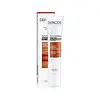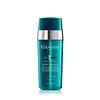What's inside
What's inside
 Key Ingredients
Key Ingredients

No key ingredients
 Benefits
Benefits

 Concerns
Concerns

 Ingredients Side-by-side
Ingredients Side-by-side

Water
Skin ConditioningDimethicone
EmollientCetearyl Alcohol
EmollientCocos Nucifera Oil
MaskingPhenyl Trimethicone
Skin ConditioningAmodimethicone
Parfum
MaskingAcetic Acid
BufferingCetyl Hydroxyethylcellulose
Emulsion StabilisingChlorhexidine Digluconate
AntimicrobialDimethiconol
EmollientGlycerin
HumectantHydrolyzed Corn Protein
Skin ConditioningHydrolyzed Soy Protein
HumectantHydrolyzed Wheat Protein
Skin ConditioningPhenoxyethanol
PreservativePolyquaternium-37
PPG-1 Trideceth-6
Skin ConditioningPropylene Glycol Dicaprylate/Dicaprate
EmollientSodium Hyaluronate
HumectantSteareth-20
CleansingTrideceth-10
CleansingTrideceth-5
EmulsifyingWater, Dimethicone, Cetearyl Alcohol, Cocos Nucifera Oil, Phenyl Trimethicone, Amodimethicone, Parfum, Acetic Acid, Cetyl Hydroxyethylcellulose, Chlorhexidine Digluconate, Dimethiconol, Glycerin, Hydrolyzed Corn Protein, Hydrolyzed Soy Protein, Hydrolyzed Wheat Protein, Phenoxyethanol, Polyquaternium-37, PPG-1 Trideceth-6, Propylene Glycol Dicaprylate/Dicaprate, Sodium Hyaluronate, Steareth-20, Trideceth-10, Trideceth-5
Cyclopentasiloxane
EmollientWater
Skin ConditioningDimethiconol
EmollientDimethicone
EmollientCetearyl Alcohol
EmollientPhenyl Trimethicone
Skin ConditioningAmodimethicone
Phenoxyethanol
PreservativePolyquaternium-37
Trideceth-5
EmulsifyingPropylene Glycol Dicaprylate/Dicaprate
EmollientSteareth-20
CleansingCetyl Hydroxyethylcellulose
Emulsion StabilisingLinalool
PerfumingGlycerin
Humectant2-Oleamido-1,3-Octadecanediol
Skin ConditioningCitronellol
PerfumingTrideceth-10
CleansingPPG-1 Trideceth-6
Skin ConditioningGeraniol
PerfumingGlycine
BufferingArginine
MaskingProline
Skin ConditioningTyrosine
MaskingGlutamic Acid
HumectantChlorhexidine Digluconate
AntimicrobialSerine
MaskingBenzyl Alcohol
PerfumingHydroxypropyltrimonium Hydrolyzed Wheat Protein
Skin ConditioningIsoeugenol
PerfumingSafflower Glucoside
Alpha-Isomethyl Ionone
PerfumingTrehalose
HumectantTamarindus Indica Seed Polysaccharide
Skin ConditioningMyrothamnus Flabellifolia Leaf Extract
EmollientParfum
MaskingCyclopentasiloxane, Water, Dimethiconol, Dimethicone, Cetearyl Alcohol, Phenyl Trimethicone, Amodimethicone, Phenoxyethanol, Polyquaternium-37, Trideceth-5, Propylene Glycol Dicaprylate/Dicaprate, Steareth-20, Cetyl Hydroxyethylcellulose, Linalool, Glycerin, 2-Oleamido-1,3-Octadecanediol, Citronellol, Trideceth-10, PPG-1 Trideceth-6, Geraniol, Glycine, Arginine, Proline, Tyrosine, Glutamic Acid, Chlorhexidine Digluconate, Serine, Benzyl Alcohol, Hydroxypropyltrimonium Hydrolyzed Wheat Protein, Isoeugenol, Safflower Glucoside, Alpha-Isomethyl Ionone, Trehalose, Tamarindus Indica Seed Polysaccharide, Myrothamnus Flabellifolia Leaf Extract, Parfum
Ingredients Explained
These ingredients are found in both products.
Ingredients higher up in an ingredient list are typically present in a larger amount.
This water-soluble silicone is used for its hydrating and softening properties. It is used to add a silky feel to skincare products and has great benefits for haircare.
In haircare, this ingredient:
- Adds shine
- Protects color
- Offers thermal protection
- Boosts hair strength
- Does not build up as easily
Cetearyl alcohol is a mixture of two fatty alcohols: cetyl alcohol and stearyl alcohol. It is mainly used as an emulsifier. Emulsifiers help prevent the separation of oils and products. Due to its composition, it can also be used to thicken a product or help create foam.
Cetearyl alcohol is an emollient. Emollients help soothe and hydrate the skin by trapping moisture.
Studies show Cetearyl alcohol is non-toxic and non-irritating. The FDA allows products labeled "alcohol-free" to have fatty alcohols.
This ingredient is usually derived from plant oils such as palm, vegetable, or coconut oils. There is debate on whether this ingredient will cause acne.
Due to the fatty acid base, this ingredient may not be Malassezia folliculitis safe.
Learn more about Cetearyl AlcoholWe don't have a description for Cetyl Hydroxyethylcellulose yet.
Chlorhexidine Digluconate is a preservative.
Dimethicone is a type of synthetic silicone created from natural materials such as quartz.
What it does:
Dimethicone comes in different viscosities:
Depending on the viscosity, dimethicone has different properties.
Ingredients lists don't always show which type is used, so we recommend reaching out to the brand if you have questions about the viscosity.
This ingredient is unlikely to cause irritation because it does not get absorbed into skin. However, people with silicone allergies should be careful about using this ingredient.
Note: Dimethicone may contribute to pilling. This is because it is not oil or water soluble, so pilling may occur when layered with products. When mixed with heavy oils in a formula, the outcome is also quite greasy.
Learn more about DimethiconeDimethiconol is a silicone that resembles the popular dimethicone. Like other silicones, it is an emollient. Emollients create a thin film on skin to prevent moisture from escaping.
This ingredient helps to create a silky texture and improve spreadability. Due to its high molecular weight and thickness, it is often combined with cyclopentasiloxane.
Glycerin is already naturally found in your skin. It helps moisturize and protect your skin.
A study from 2016 found glycerin to be more effective as a humectant than AHAs and hyaluronic acid.
As a humectant, it helps the skin stay hydrated by pulling moisture to your skin. The low molecular weight of glycerin allows it to pull moisture into the deeper layers of your skin.
Hydrated skin improves your skin barrier; Your skin barrier helps protect against irritants and bacteria.
Glycerin has also been found to have antimicrobial and antiviral properties. Due to these properties, glycerin is often used in wound and burn treatments.
In cosmetics, glycerin is usually derived from plants such as soybean or palm. However, it can also be sourced from animals, such as tallow or animal fat.
This ingredient is organic, colorless, odorless, and non-toxic.
Glycerin is the name for this ingredient in American English. British English uses Glycerol/Glycerine.
Learn more about GlycerinParfum is a catch-all term for an ingredient or more that is used to give a scent to products.
Also called "fragrance", this ingredient can be a blend of hundreds of chemicals or plant oils. This means every product with "fragrance" or "parfum" in the ingredients list is a different mixture.
For instance, Habanolide is a proprietary trade name for a specific aroma chemical. When used as a fragrance ingredient in cosmetics, most aroma chemicals fall under the broad labeling category of “FRAGRANCE” or “PARFUM” according to EU and US regulations.
The term 'parfum' or 'fragrance' is not regulated in many countries. In many cases, it is up to the brand to define this term.
For instance, many brands choose to label themselves as "fragrance-free" because they are not using synthetic fragrances. However, their products may still contain ingredients such as essential oils that are considered a fragrance by INCI standards.
One example is Calendula flower extract. Calendula is an essential oil that still imparts a scent or 'fragrance'.
Depending on the blend, the ingredients in the mixture can cause allergies and sensitivities on the skin. Some ingredients that are known EU allergens include linalool and citronellol.
Parfum can also be used to mask or cover an unpleasant scent.
The bottom line is: not all fragrances/parfum/ingredients are created equally. If you are worried about fragrances, we recommend taking a closer look at an ingredient. And of course, we always recommend speaking with a professional.
Learn more about ParfumPhenoxyethanol is a preservative that has germicide, antimicrobial, and aromatic properties. Studies show that phenoxyethanol can prevent microbial growth. By itself, it has a scent that is similar to that of a rose.
It's often used in formulations along with Caprylyl Glycol to preserve the shelf life of products.
Phenyl Trimethicone is a silicon-based polymer. It is derived from silica.
Phenyl Trimethicone is used as an emollient and prevents products from foaming.
As an emollient, it helps trap moisture in the skin. It is considered an occlusive.
Learn more about Phenyl TrimethiconeWe don't have a description for Polyquaternium-37 yet.
We don't have a description for PPG-1 Trideceth-6 yet.
Propylene Glycol Dicaprylate/Dicaprate is a mixture of Propylene Glycol Dicaprylate and Propylene Glycol Dicaprate.
It is an emollient and helps hydate the skin.
Steareth-20 is a waxy compound used to emulsify ingredients. It is created from stearyl alcohol.
It possesses surfactant properties. This means it reduces surface tension and helps oils, dirt, and pollutants to be washed away.
The 20 stands for the number of ethylene oxide used to create this ingredient.
Learn more about Steareth-20We don't have a description for Trideceth-10 yet.
We don't have a description for Trideceth-5 yet.
Water. It's the most common cosmetic ingredient of all. You'll usually see it at the top of ingredient lists, meaning that it makes up the largest part of the product.
So why is it so popular? Water most often acts as a solvent - this means that it helps dissolve other ingredients into the formulation.
You'll also recognize water as that liquid we all need to stay alive. If you see this, drink a glass of water. Stay hydrated!
Learn more about Water